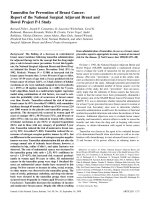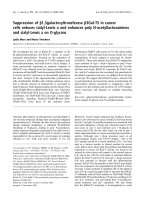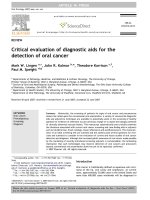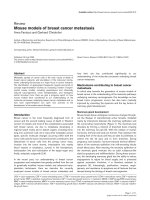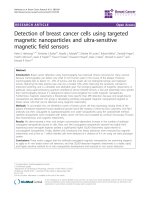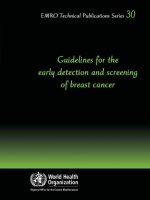Detection of breast cancer cells using targeted magnetic nanoparticles and ultra-sensitive magnetic field sensors potx
Bạn đang xem bản rút gọn của tài liệu. Xem và tải ngay bản đầy đủ của tài liệu tại đây (1.03 MB, 13 trang )
RESEARCH ARTIC LE Open Access
Detection of breast cancer cells using targeted
magnetic nanoparticles and ultra-sensitive
magnetic field sensors
Helen J Hathaway
1,2*†
, Kimberly S Butler
3†
, Natalie L Adolphi
2,4
, Debbie M Lovato
3
, Robert Belfon
1
, Danielle Fegan
5
,
Todd C Monson
6
, Jason E Trujillo
3,5
, Trace E Tessier
5
, Howard C Bryant
5
, Dale L Huber
7
, Richard S Larson
2,3
and
Edward R Flynn
2,5
Abstract
Introduction: Breast cancer detection using mammography has improved clinical outcomes for many women,
because mammography can detect very small (5 mm) tumors early in the course of the disease. However,
mammography fails to detect 10 - 25% of tumors, and the results do not distinguish benign and malignant
tumors. Reducing the false positive rate, even by a modest 10%, while improving the sensitivity, will lead to
improved screening, and is a desirable and attainable goal. The emerging application of magnetic relaxometry, in
particular using superconducting quantum interference device (SQUID) sensors, is fast and potentially more specific
than mammography because it is designed to detect tumor-targeted iron oxide magnetic nanoparticles.
Furthermore, magnetic relaxometry is theoretically more specific than MRI detection, because only target-bound
nanoparticles are detected. Our group is developing antibody-conjugated magnetic nanoparticles targeted to
breast cancer cells that can be detected using magnetic relaxometry.
Methods: To accomplish this, we identified a series of breast cancer cell lines expressing varying levels of the
plasma membrane-expressed human epidermal growth factor-like receptor 2 (Her2) by flow cytometry. Anti-Her2
antibody was then conjugated to superparamagnetic iron oxide nanoparticles using the carbodiimide method.
Labeled nanoparticles were incubated with breast cancer cell lines and visualized by confocal microscopy, Prussian
blue histochemistry, and magnetic relaxometry.
Results: We demonstrated a time- and antigen concentration-dependent increase in the number of antibody-
conjugated nanoparticles bound to cells. Next, anti Her2-conjugated nanoparticles injected into highly Her2-
expressing tumor xenograft explants yielded a significantly higher SQUID relaxometry signal relative to
unconjugated nanoparticles. Finally, labeled cells introduced into breast phantoms were measured by magnetic
relaxometry, and as few as 1 million labeled cells were detected at a distance of 4.5 cm using our early prototype
system.
Conclusions: These results suggest that the antibody-conjugated magnetic nanoparticles are promising reagents
to apply to in vivo breast tumor cell detection, and that SQUID-detected magnetic relaxometry is a viable, rapid,
and highly sensitive method for in vitro nanoparticle development and eventual in vivo tumor detection.
* Correspondence:
† Contributed equally
1
Department of Cell Biology & Physiology, University of New Mexico School
of Medicine, MSC08 4750, 1 University of New Mexico, Albuquerque, NM
87131, USA
Full list of author information is available at the end of the article
Hathaway et al. Breast Cancer Research 2011, 13:R108
/>© 2011 Hathaway et al.; licensee BioMed Central Ltd. This is an open access article distributed under the terms of the Creative
Commons Attribution License (http://cre ativecommons.org/licenses/by/2.0), which permits unrestricted use, distribution, and
reproduction in any medium, provided the original work is properly cited.
Introduction
New cases of invasive breast cancer were predicted to
exceed 207,000 in the US, where an estimated 39,840
women d ied of breast cancer in 2010 [ 1]. Currently,
detection is routinely done by mammogram, which has
significantly improved breast cancer outcomes, but mam-
mograms cannot distinguish between benign and malig-
nant lesions [2]; biopsy is required to confirm or rule out
cancer. Furthermore, tumors in dense or scarred breast
tissue or in augmented breasts are difficult to detect by
mammography, and the best estimates suggest that mam-
mography fails to detect 10% to 25% of breast cancers [3].
Improvements in breast cancer detection, particularly
with technology that can distinguish malignant from
beni gn lesions, improve upon the current sensitivity and,
if applied to radio-opaque breasts, would be a tremen-
dous advance. In addition, the ideal technology will be
inexpensive and rapid and can be accomplished with lit-
tle or no discomfort to the patient.
Increasing specificity in b reast cancer detection will
requiretheuseofspecificmarkersthatcandistinguish
between malignant and benign lesions. The ideal marker
would have high specificity toward cancer cells relative to
normal cells and the target(s) would be represented on a
high proportion of tumor typ es. Although grea t progress
has been made in this field and many promising targets
have been identified, the ideal target remains elusive [4].
Analternativestrategyinvolvestheuseofmarkercock-
tails, allowing the development of unique combinations
for individual patients with diffe rent tumor expression
profiles. This is most feasible in follow-up and therapeutic
settings since the cancer has already been identified and
characterized. In anticipation of the identification of new
markers in the future and the possibility of using cocktails,
we are focusing on the development of a universal probe,
based on iron oxide nanoparticles, and developing a uni-
versal conjugation method to allow targeting by any anti-
body or peptide to tumor cell surface targets. This strategy
will allow the probe to be targeted to new molecules as
they are discovered and allow the development of persona-
lized cocktails based on individual patient histology. In the
development phase, described here, we have selected
human epidermal growth factor-like receptor 2 (Her2), a
surface antigen that is overexpressed in approximately
30% of breast cancers [5]. Her2 is well characterized, and a
variety of antibody-based targeting methods are available;
therefore, Her2 is an ideal prototypical breast cancer cell
surface target.
The use of magnetic nanoparticles conjugated to
tumor-specific probes combined with detection of these
particles through measurement of their relaxing fields
following a magnetization pulse represents a promising
new technology that has the potential to i mprove our
ability to detect tumors earlier because of high theoretical
sensitivity [6]. We have developed a novel nanotechnol-
ogy method based on the use of magnetic nanoparticles
labeled with specific antibodies for breast cancer and
ultra-sensitive detection of these particles by using
Superconducting Quantum Interference Device (SQUID)
sensors [7]. Magnetic relaxometry [6,8-10] for detection
of targeted magnetic nanoparticles is fast and theoreti-
cally is more specific than magnetic resonance imaging
detection since only partic les bound to their targets are
detected, eliminating the problems associated with sig-
nals from unbound particle s.Themagneticmoments
observed by magnetic relaxome try are also linear with
the number of nanoparticl es bound to the tumor and
may be used to determine the number of cancer cells in
the tumor [8]. In magnetic relaxometry, magnetic nano-
particles that have been conjugated to antibodies or
other agents are incubated with live cells [11]. After a
brief period, the nanoparticles attach to the targeted cells
in large numbers, typically on the order of 100,000 nano-
particles per cell [11,12]. A magnetizing pulse of less
than 1 seco nd is applied with a set of Helmholtz coils to
achieve a uniform magnetizing field over t he sample. A
field of 40 gauss is adequate to appreciably polarize these
nanoparticles, which are typicall y 25 nm in diameter,
resulting in an induced collective magnetic moment.
After the magnetizing field is removed, the magnetic
moment decays thr ough the Néel mechanism [13] with a
time constant on the order of 1 second. This decaying
field is measured by an array of second-order gradi-
ometer SQUID sensors [6].
Our long-term goal is t o develop magnetic nanoparti-
cle-based magnetic imaging to detect in vivo malignan-
cies with high sensitivity and specificity. To this end, we
first set out (a) to identify appropriate magnetic nano-
particles for SQUID-detected magnetic relaxometry of
breast cancer, (b) to develop reproducible methods for
conjugating antibody or peptide probes, (c) to identify
appropri ate in vitro breast cancer models with which to
test conjugated nanoparticle binding specificity, and (d)
to determine the ability of magnetic relaxome try to spe-
cifically detect conjugated na noparticles bound to cells.
Wedemonstratethatwehaveachievedanti-Her2anti-
body conjugation to magnetic nanoparticles and that
these antibody-conjugated nanoparticles display mag-
netic properties that make them ideal for magnetic
detection with SQUID sensors. Further more, antibody-
conjugated nan oparticles bind in greater numbers to
breast cancer cells expressing high levels of Her2 com-
pared with cells expressing low H er2. Our results sug-
gest that this approach is a promising first step toward
the d evelopment of novel magnetic -based cancer dete c-
tion in vivo.
Hathaway et al. Breast Cancer Research 2011, 13:R108
/>Page 2 of 13
Materials and methods
Materials
Carboxyl-functionalized iron oxide nanoparticles (SHP-30
Lot SAO5) with a nominal diameter of 30 nm were pur-
chased from Ocean NanoTech (Springdale, AR, USA).
N-hydroxysulfosuccinimide (Sulfo-NHS) and 1-ethyl-3-[3-
dimethylaminopropyl]carbodiimide hyd rochloride (EDC)
were purchased from Pierce (Rockford, IL, USA). Trypan
blue, albumin solution from bovine serum, sodium azide,
potassium ferrocyanide, NaHCO
3
, and ethylenediaminete-
traacetic acid (EDTA) were purchased from Sigma-Aldrich
(St. Louis, MO, USA). Anti-Her2 antibody was purchased
from Ben der MedSystems (now part of eBioscience, Inc.,
San Diego, CA, USA). Phosphate-buffered saline (PBS)
was purchased from Gibco-BRL (now part of I nvitrogen
Corporation, Carlsbad, CA, USA), and fetal bovine serum
(FBS) was purchased from HyClone (Logan, UT, USA).
Diff-Quik stain was purchased from Dade Behring (now
part of Siemens, Munich, Germany) and Brazilliant stain
was purchased from Anatech Ltd. (Battle Creek, MI,
USA). Xanthene dye was purchased from Siemens. Cyt o-
seal XYL was purchased from Richard-Allan Scientific
(now part of Thermo Fisher Scientific Inc., Waltham, MA,
USA). Matrigel™ recombinant basement mem brane was
purchased from Fisher Scientific (Pittsburgh, PA, USA).
DC susceptometry
DC magnetic characterizations of stock nanoparticles were
performed with an MPMS-7 SQUID magnetometer sys-
tem (Quantum Design, San Diego, CA, USA). DC magne-
tization curves were acquired by equilibrating the sample
at the measurement temperature in zero field, incremen-
tally increasing the field, and pausing 100 seconds at each
field before me asurement. Five sequential measurements
were taken at each field, a mean of those measurements
was calculated, and the three values with the lowest devia-
tion from the mean were averaged and reported as the
moment. Zero-field cooled curves were determined by
cooling the sample in the absence of a magnetic field to
5 K and then slowly warming in a 1-mT field. After ther-
mal equilibration at a target temperature, a series of five
measurements was taken and the values were processed as
described to obtain the magnetization value.
Transmission electron microscopy
The nanoparticles were imaged by transmission electron
microscopy (TEM) by using a Tecnai G
2
F30 transmission
electron microscope at 300 kV (FEI Corporation, Hills-
boro, OR, USA). Size distributions were determined from
the TEM images by using ImageJ (public domain software
from the National Institutes of Hea lth). Br iefly, the Feret
diameter (defined as the maximum caliper diameter) was
measured from a sample of approximately 1,000 particles
selected from multiple TEM i mages. Particles in contact
with the edge of an image were automatically excluded,
and overlapping particles were manually excluded from
the size analysis.
Magnetic relaxometry
To measure the desired Néel relaxation of the nanoparti-
cles by relaxometry, the particles must be immobilized. In
the case of cell samples, the antibody-conjugated nanopar-
ticles were immobilized by the binding of the antibodies to
receptors on the cell surface (described below). For cali-
bration purposes, a known quantity of the same nanoparti-
cle solution was applied to a Q-tips cotton swab (Unilever,
Trumbull, CT, USA) and allowed to dry in air.
In this study, the nanoparticles were subjected to a mag-
netizing field of approximately 40 gauss for 0.75 seconds
followed by a delay of 35 milliseconds and subsequent
detection every millisecond of the relaxing magnetic field
for 2.2 seconds by using a s even-channel SQUID sensor
array (BTi 2004; 4D-Neuroimaging, San Diego, CA, USA),
which has been describ ed in detail elsewhere [6]. The
SQUID sensors operate in a non-shielded environment,
achievable by the second-order gradiometer cancellation of
background fields, and have a noise floor of approximately
2pT/√Hz. This sequence was repeated 10 times and the
result was signal-averaged to increase the signal-to-noise
ratio. The samples were uniformly polarized (parallel to the
center gradiometer axis) by using a 49-cm diameter, 100-
turn Helmholtz pair powered by a 5-kW current-regulated
supply (Sorenson SGA 80/63). The current through the
magnetizing coils was monitored by a Hall effect transdu-
cer to ensure constant magnetic fields. The relaxometry
data were recorded with a National Instruments PXI8336
16-channel digitizer (National Instruments Corporatio n,
Austin, TX, USA).
Data analysis was performed with the Multi-Source
Analysis program, written in our lab by using MATLAB
(The MathWorks Inc. , Natick, MA, USA). After removal
of 60-cycle contamination and other artifacts that occur
because of external noise, the d ata were signal-averaged.
Background data (acquired with no sample) were sub-
tracted from the sample data to compensate for back-
ground fields arising from induced currents following the
magnetic field pulse. The relaxation curves were fit by a
logarithmic function at long times (to determine the DC
offset) and an exponential function at short times to
obtain the magnetic field amplitude at each sensor posi-
tion [6]. To solve the electromagnetic inverse problem, we
fit the spatial dependence of the magnetic field by model-
ing the sample as one or more discrete magnetic dipoles,
which allows us to determine the location (x, y, z) and
magnetic moment (m
z
) of each dipole. In solving the
inverse pr oblem b y this modeling approach, w e used the
fact that the direction of the magnetic dipoles induced in
thesourceisparalleltotheapplied magnetizing field.
Hathaway et al. Breast Cancer Research 2011, 13:R108
/>Page 3 of 13
Knowledge of the vector direction of the magnetic dipole
moments yielded increased precision in determining the
spatial coordinates of the sources. The least-squares fit
was performed by us ing the Levenberg-Marquardt algo-
rithm. To determine the spatial coordinates and moments
for multiple discrete sources, data were obtained by using
n different sample positions - equivalent to a sensor array
with 7n elements - such that 7n (the number of field
amplitudes obtained) exceeds 4s (the number of
unknowns for s discrete sources). Confidence limits (95%)
obtained from f itting the data to a dipole model indicate
that 1-mm accuracy was typically obtained for a magnetic
moment on the order of 10
-7
J/T or greater located several
centimeters from the sensor system.
Iron assay
The iron concentration (mg[Fe] per milliliter) of nanopar-
ticle samples was determined destructively by dissolving
them in acid, forming the phenanthroline/Fe
2+
complex,
and th en quantifying the concentration of a known dilu-
tion spectrophotometrically [14].
Cell lines and flow cytometry
MCF7, BT-474, and MDA-MB-231 breast cancer ce lls
and Chinese hamster ovary (CHO) cells were purchased
from the American Type Culture Collection (Manassas,
VA, USA). MCF7 cells transfected to overexpress Her2
antigen, designated MCF7/Her2-18, were kindly provided
byMien-ChieHung(TheUniversityofTexasM.D.
Anderson Cancer Center, Houston, TX, USA) [15].
MCF7/Her2-18 cells were cultured in advanced Dulbec-
co’smodifiedEagle’s medium/F-12 medium supplemen-
ted with 10% FBS (vol/vol) 1% penicillin streptomycin
(vol/vol) and 4 μg/mL ciprofloxacin. MDA-MB-231 cells
were cultured in Leibo vitz’s L-15 med ium supplemented
with 10% FBS (vol/vol), 1% penicillin streptomycin (vol/
vol), and 4 μg/mL ciprofloxacin. CHO cells were cultured
in RPMI 1640 medium supplemented with 10% FBS (vol/
vol), 1% penicillin streptomycin (vol/vol), and 4 μg/mL
ciprofloxacin. MCF7/Her2-18 and parental CHO cells
were cultured in an incubator at 37°C with 5% CO
2
and
maintained at a cell concentration of between 1 × 10
5
and 1 × 10
6
viable cells/mL. MDA-MB-231 cells were
cultured in an incubator at 37°C with no CO
2
and main-
tained at a cell concentration of between 1 × 10
5
and 1 ×
10
6
viable cells/mL. For antibody and nanoparticle label-
ing of attached cells, cells were cultured on acid-washed
glass coverslips. Qua ntification o f Her2 site density
was performed as previously described by using approxi-
mately 10
5
cells and an anti-human p185
Her2
(cell-ery-
throblastic leukemia viral oncogene homolog 2, or
c-erbB2) fluorescein isothiocyanate (FITC) antibody
(Invitrogen Corporation) [11].
Nanoparticle conjugation
The antibody was attached to the nanoparticles by using
the carbodiimide method, as previously described [11],
with the exception of centrifugation speed, which was
increased to 7,500 g to account for the use of smaller
(30 nm) n anoparticles. Anti-Her2-conjugated nanopar ti-
cles were stored at 4°C prior to use.
Cell labeling and sampling
MCF7/Her2-18, parental CHO, or MDA-MB-231 cells
were harvested with EDTA and washed with ster ile PBS .
Harvested cells were counted by using 0.4% Trypan blue
solution on a hemocytometer (Hausser Scientific,
Horsham, PA, USA). Each sample consisted of 7.5 × 10
6
cells suspended in 200 μL of cold media to which 0.8 mg
of anti-Her2/neu-coupled nanoparticles was added. Sam-
ples in 1.5-mL microcentrifuge tubes were centered under
the seven-channel SQUID sensor array. Cells and Her2/
neu-nanoparticles were incubated on ice for 15 minutes,
and SQUID measurements were taken every 2 minutes,
starting at 1 minute after nanoparticle addition.
Cytospin slides were prepared by adding 200 μLof
bovine serum albumin solution with 5 μLofcell/nasophar-
yngeal sample to a cytofunnel. The slides were then placed
in a Shandon Cytospin 4 machine (Thermo Fisher Scienti-
fic Inc.) and centrifuged at 1,100 g for 7 minutes. Slides
were stained with either Diff-Quikstain, which is similar to
a Wright-Giemsa stain, or Prussian blue stain, which
reveals the presence of iron. For Prussian blue stain, slides
were then fixed by dipping five times in 0.01% sodium
azide in 1 g/L xanthene dye. Potassium ferrocyanide solu-
tion (a 1:1 solution of 20% of hydrochloric acid and 10%
potassium ferrocyanide) was prepared fresh, applied
directly to the cell sample on the slide, and incubated in
the dark for 20 minutes. The slides were then dipped in
double -distilled water three times. Brazilliant was applied
directly to the cell sample on the slide and incubated in the
dark for 5 minutes. After Prussian blue or Diff-Quik stain-
ing, the slide s were dipped in double-distilled water three
times and allowed to dry. The slides were then cover-
slipped with Cytoseal XYL. Stained samples were qualita-
tively assessed for nanoparticle attachment by using light
microscopy. Light microscopy was performed on an Axio-
vert 200 MAT microscope (Zeiss, Munich, Germany), and
images were captured with a Moticam 2300 camera and
Motic Images Plus software (Motic, Xiamen, China).
Confocal microscopy
Cells grown on glass coverslips were incubated with
nanoparticles as described above and then fixed in 4%
paraformaldehyde in PBS. After several washes in PBS,
cells were blocked in PBS containing 5% norma l goat
serum (NGS) and then incubated in goat anti-mouse
Hathaway et al. Breast Cancer Research 2011, 13:R108
/>Page 4 of 13
IgG conjugated to Alexa 488 (Invitrogen Corporation)
(diluted 1/250 in PBS/NGS) for 45 minutes at room
temperature. During the last 20 minutes of incub ation,
26 nM rhodamine-conjugated phalloidin (Invitrogen
Corporation) was added in order to label actin filaments.
After washing in PBS, cells were incubated in 4’,6-diami-
dino-2-phenylindole (DAPI) or Topro-3 (Invitrogen
Corporation) to counterstain nuclei and were inverted
onto a drop of anti-fade mounting media on a glass
slide. Images were captured on a Zeiss 510 confocal
microscope an d were further manipulated (channels
merged and labels added) by using Adobe Photoshop
software (Adobe Systems, Inc., San Jose, CA, USA).
For immunofluorescence assays, cells were fixed in 4%
paraformaldehyde, washed, and then incubated over-
night at 4°C in ant i-Her2 antibody (clone 2G11; Bender
MedSystems) diluted 1/300 in PBS/NGS. After washing
in PBS, cells were incubated in goat anti-mouse IgG-
Alexa 488 and rhodamine phalloidin, washed, and
mounted as described above.
Generation of xenograft tumors in mice
B6.129S7-Rag1
tm1Mom
/J mice were purchased from The
Jackson Lab oratory (Bar Harbor, ME, USA), and athymic
nude mice were purchased from Harlan Laboratories
(Indianapolis, IN, USA). Two to seven days prior to injec-
tion of cells, mice were implanted with a 17b-estradiol pel-
let (1.7 mg, 60-day release; Innovative Research of
America, Sarasota, FL, USA). MCF7/Her2-18 cells (1.5 ×
10
6
) were injected with 0.150 mL of Matrigel™ into each
hind limb flank. Tumor growth was followed by using cali-
pers, and all mice were used when tumors reached around
1 cm by 1 cm. Mice were killed by cervical dislocation
under isofluorane anesthesia. Tumors were excised, cut
into slices, and injected with 0.175 mg of either anti-Her2
antibody-conjugated or unconjugate d nanoparticles by
using multiple small injections (total volume of 17.5 μL).
Tumor slices were incubated with nanoparticles for 15
minutes and washed in PBS with agitation to remove
unbound nanoparticles, and then bound nanoparticles
were detected by SQUID relaxometry. Tumor slices were
then fixed in 4% paraformaldehyde and processed for
Prussian blue staining of paraffin-embedded sections (Tri-
Core Laboratories, Albuquerque, NM, USA). All animal
procedures were performed in accordance with the
National Institutes of Health Guide for the Care and Use
of Laboratory Animals and approved by the Institutional
Animal Care and Use Committee.
Results and discussion
Characterization of nanoparticles demonstrated a narrow
size distribution and strong magnetic moment
Several lots of iron oxide magnetic nanoparticles were
evaluated by m agnetic relaxometry to determine the lot
that yielded the maximum detectable magnetic moment
per mg[Fe]. For consistency, all subsequent experiments
were performed with this lot (SHP-30 lot SAO5). Theo-
retically, the relaxation time of bound nanoparticles has a
strong (exponential) dependence on the particle volume
[13] and therefore it is critical that the nanoparticles fall
within a narrow diame ter range (near 25 nm) to ensure
that their relaxation times are detectable on the timescale
of the relaxometry measurement (35 to 2,200 ms, in this
case). Figure 1a (inset) shows a TEM image of the SAO5
nanoparticles, which are composed o f a single magnetic
core of relatively uniform size, coated with a thin layer of
polymer, and functionalized with carboxyl groups. The
size distribution shown in Figure 1a was obtained by ana-
lyzing approximately 1,000 nanoparticles from multiple
TEM fields and yielded an average particle diameter of
27 nm, which is in close agreement with the nominal size
of 30 nm, and a standard deviation of 4.3 nm. The mag-
netic moment per mg[Fe] detected by relaxometry was
7.3 × 10
-7
J/T per mg[Fe], which represents a threefold
improvement in detection sensitivity compared with pre-
vious studies [11,16] using multi-core particles.
Nanoparticles (10 μL containing 0.049 mg[Fe]) were
immobilized on a cotton tip to characterize their magnetic
properties by susceptometry. At room temperature, the
magnetization curve (Figure 1b, M versus B) shows that
the nanoparticle moment is not completely saturated at
6 T. Measurement of the magnetic moment as a function
of temperature (not shown) revealed an average blocking
temperature of 350 K, indicating that, at room tempera-
ture, only some particles are unblocked and contribute to
the relaxometry signal. Blocked particles exhibit relaxation
times that are too slow for detection by relaxometry. A
numerical fi t to the magnetization curve (solid line) sug-
gests that, at a higher field, the nanoparticle moment
would reach 5.5 × 10
-6
J/T, implying that the saturation
magnetization (M
s
)is81J/Tperkg[Fe
3
O
4
], which is
slightly lower than the saturation magnetization of bulk
magnetite (92 J/T per kg). These data further imply that
the magnetic moment observed by relaxometry is slightly
less than 1% of the saturation magnetic moment observed
by DC susceptometry (Figure 1b), and this is consistent
with the observation that many particles are larger than
the ideal diameter of 25 nm (Figure 1a) and therefore are
blocked at room temperature.
Breast cancer cell lines express distinct and measurable
Her2 expression levels
Initially, we identified the Her2 t yrosine kinase as an
appropriate surface antigen target to assess the efficiency
and sensitivity of detection of nanoparticles by using
SQUID relaxometry. We quantified Her2 receptor levels
on several cell lines reported to express varying levels of
Her2, including breast cancer cell lines MCF7/Her2-18
Hathaway et al. Breast Cancer Research 2011, 13:R108
/>Page 5 of 13
(an MCF7 clone stably transfected with Her2) [15],
MCF7, BT-474, and MDA-MB-231 [17] as well as several
non-breast cell lines. The number of Her2-binding sites
was determined by flow cytometry with anti-Her2 antibo-
dies conjugated to the fluorescent probe FITC. Flow
cytometric profiles, with cell number plotted as a func-
tion of fluorescence intensity, for three representative
breast cancer cell lines are shown in Figure 2a. The num-
ber of Her2 sites per cell is calculated as described in
Materials and methods, and results are shown in Figure
2b. As expected, MCF7 cells engineered to overexpress
Her2-18 have a very high number of Her2-binding sites
per cell ( 8.3 × 10
6
), followed by BT-474 (3.7 × 10
6
),
MCF7 (0.23 × 10
6
), and MDA-MB-231 (0.07 × 10
6
). Sev-
eral non-breast cell lines have a very low number of
Her2-binding sites per cell; CHO cells (< 4,000) are
shown. Another report describes quantitation of Her2
receptor numbers on several breast cancer cell lines,
including MCF7, BT-474, and MDA-MB-231, by using
fluorescence-activated cell sorting analysis [17]. In that
report, the absolute numbers of receptors per cell are 6-
to 13-fold lower compared with our data, but the results
are proportionally similar; that is, BT-474 had the highest
receptors per cell, whereas MDA-MB-231 had the lowest
of these three cell lines. Therefore, we have identified a
panel of cell lines with varying levels of Her2 expression
on the cell surface to use in subsequent experiments to
assess the efficacy, specificity, and sensitivity of anti-Her2
antibody-conjugated magnetic nanoparticles.
Binding of antibody-conjugated nanoparticles to Her2-
expressing cell lines demonstrated specific binding based
on Her2 expression
To evaluate ligand-specific nanoparticle binding behavior,
cell lines with varied Her2 expression, including MCF7/
Her2-18, MDA-MB-231, and CHO, were incubated with
ant i-Her2 antibo dy-tagged nanopart icles for 15 minutes.
Cells were assessed for nanoparticle binding by relaxome-
try every 2 minutes, starting 1 minute after nanoparticle
addition. Results showe d a sharp increase in relaxome try
signal between the nanoparticles alone (time 0) and after
1 minute of incubation (Figure 3a). Signal was maximal
after 5 minutes of incubation. The relaxometry signal
increased with increasing Her2 receptor number; back-
ground due to anti-He r2-conjugated nanoparticles in the
absence of cells was very low. MCF7/Her2-18 cells demon-
strated the highest maximal relaxometry signal (700,500
pJ/T), MDA-MB-231 had an intermediate maximal relaxo-
metry signal (435,500 pJ/T), CHO had a low maximal
relaxometry signal (268,000 pJ/T), and media alone
demonstrated a minimal background signal (29,000 pJ/T).
After the relaxometry measurement, cytospin slide pre-
parations were stained with Prussian blue to non-quantita-
tively visualize iron oxide nanoparticles histochemically.
AB
Figure 1 Characterization of SAO5 nanoparticles. (a) SAO5 nanoparticles w ere imaged by transmission electron micr oscopy (inset). The
diameters of approximately 1,000 nanoparticles were measured, and the mean and standard deviation were determined. (b) SAO5 nanoparticles
dried onto a cotton tip were measured by DC susceptometry to determine the total magnetic moment (M) as a function of applied field (B).
Hathaway et al. Breast Cancer Research 2011, 13:R108
/>Page 6 of 13
Qualitatively, MCF7/Her2-18 samples showed the highest
level of cell-associated anti-Her2 antibody-conjugated
nanoparticles, MDA-MB-231 cells showed intermediate
binding of targeted nanoparticles, and CHO cells showed a
low level of nanoparticle binding ( Figure 3b); this is in
agreement with the calculat ed number of Her2 receptors.
Antibody-conjugated nanoparticles incubated with Her2-
expressing cells were localized to the cell surface
The above results suggest li gand-specific binding of anti-
body-conjugated nanoparticles to cells, so we n ext aske d
whether nanoparticles remain associated with the cell sur-
face or whether they are internalized and, if so, what th e
time course of the internalization is. To a ddress this, we
incubated cells with antibody-conjugated nanoparticles as
described and then fixed and detected the bound nanopar-
ticles by indirect immunofluorescence by using Alexa 488-
conjugated anti-mouse IgG. Cells were also incubated
with rhodamine phalloidin to fluorescently label the actin
cytoskeleton and were counterstained with DAPI or
Topro-3 to visualize nuclei. In parall el assays, Her2 anti-
gen was detected by using standard immunofluorescence
microscopy. As shown in Figure 4, we detected abundant
Her2 on the surface of MCF7/Her2-18 cells transfected
with Her2 (Figure 4a). MDA-MB-231 cells appear to
express Her2 in cytoplasmic vesicles but do not express
the antigen on the cell surface, and this in agreement with
previous observations (Figure 4b). CHO cells do not
express any immunodetectable Her2 (Figure 4c). Using
confocal microscopy and fluorescent detection of nanopar-
ticles, we detected significant nanoparticle association with
MCF7/Her2-18 cells (Figure 4e, f), reduced nanoparticle
association with MDA-MB-231 cells (Figure 4g), and none
with CHO cells (Figure 4h). These results are consistent
with the quantitation of surface-expr essed Her2 antigens
(Figure 2), and with the detection of Her2 antigen by
immunofluorescence (Figure 4a-c). Therefore, the binding
of anti-Her2-labeled magnetic nanoparticles to live cells
AB
Her2
Isotype
Cells
only
BT-474
Isotype
Her2
Cells
only
MCF7/Her2-18
Cells
only
Her2
Isotype
MDA-MB-231
Figure 2 Characterization of Her2 expression on breast cancer cell lines. We examined several breast cancer cell lines to identify cells that
expressed Her2. The number of Her2-binding sites was determined by flow cytometry with anti-Her2 antibody conjugated to fluorescein. (a)
Flow cytometric profiles, with cell number plotted as a function of fluorescence intensity, for three representative breast cancer cell lines are
shown. (b) The number of Her2 sites per cell is calculated by comparison with a range of microspheres with known binding capacities. As
expected, MCF7 breast cancer cells engineered to overexpress Her2-18 have a very high number of Her2-binding sites per cell (11.28 × 10
6
),
followed by BT-474 breast cancer cells (2.75 × 10
6
), MCF7 breast cancer cells (0.18 × 10
6
), and MDA-MB-231 breast cancer cells (0.11 × 10
6
). The
Chinese hamster ovary (non-breast) cell line has a very low number of Her2-binding sites per cell (< 4,000). Her2, human epidermal growth
factor-like receptor 2.
Hathaway et al. Breast Cancer Research 2011, 13:R108
/>Page 7 of 13
and their subsequent detection correspond directly to the
localization and density of Her2 on cell surfaces. These
results suggest that antibody-labeled nanoparticles repre-
sent a sensitive and accurate tool for detection of cells dis-
playing surface-localized antigens.
The SQUID relaxometry system detected antibody-
conjugated nanoparticles bound specifically to breast
tumor explants grown as xenografts
Cells in culture allow greater access of the nanoparticles to
the cell surface than is anticipated in a solid tumor. To
demonstrate the ability of the antibody-labeled nanoparti-
cles to bind to breast cancer cells grown as tumors and to
assess the capability of the magnetic relaxometry system
to detect bound nanoparticles, we assessed binding of
anti-Her2 antibody-conjugated nanoparticles to explanted
MCF7/Her2-18 cell tumors grown as subcutaneous xeno-
grafts. Slices of MCF7/Her2-18 tumors were injected with
nanoparticles conjugated to anti-Her2 antibody or uncon-
jugated nanoparticles and washed to remove unbound
nanoparticles. This experiment was repeated with four
separatetumorsandshowedasignificant(P = 0.049)
increase in the magnetic relaxometry signal when anti-
Her2 antibody-conjugated nanoparticles were injected
compared with unconjugated nanoparticles (Figure 5a).
To confirm that the difference in magnetic relaxometry
signal was due to nanoparticle binding to tumor cells, par-
affin-embedded tumor sections were stained with Prussian
blue to detect iron nanoparticles within tumors (Figure
5b). A low level of Prussian blue staining is seen in tumors
A
B
Figure 3 SQUID detection of nanoparticle binding versus time. (a) Cells (7.5 × 10
6
) from each breast cancer cell line or media alone were
incubated with 0.8 mg of nanoparticles for 15 minutes on ice. SQUID measurements were taken every 2 minutes. The curves represent non-
linear fits of the data. Data represent results from two separate experiments, and error bars represent the standard deviation. (b)
Photomicrographs show 40× imaging of Prussian blue histochemical staining for the presence of iron oxide nanoparticles on cells incubated
with anti-Her2 antibody-conjugated nanoparticles. Scale bars = 20 μM. Her2, human epidermal growth factor-like receptor 2; SQUID,
Superconducting Quantum Interference Device.
Hathaway et al. Breast Cancer Research 2011, 13:R108
/>Page 8 of 13
injected with unconjugated nanoparticles, and this li kely
reflects a degree of tissue trapping of unbound nanoparti-
cles and is in agreement with the magnetic relaxometry
signal detection in t hat sample . Importantly, increased
Prussian blue staining is visible in the tumor slices micro-
injected with anti-Her2 antibody-conjugated nanoparticles
comp ared with the unconjugated nanoparticles . Examin-
ing the anti-Her2 antibody-conjugated nanoparticle bind-
ing at higher magnification suggests that, as expected, the
binding is cell surface-associated (Figure 5b). However, the
distribution of the nanoparticles was not uniform, suggest-
ing heterogeneity in antibody-conjugated nanoparticle
access to tumor cells within the tumor environment.
These results demonstrate that targeted nanoparticles pro-
duce an increased relaxometry signal as expected but that
the distribution of targeted nanoparticles in tumors in vivo
is non-uniform.
The SQUID relaxometry method detected and localized
nanoparticle-labeled breast cancer cells embedded within
a breast phantom
An important question regarding detection of tumors in
patients is sensitivity. Sensitivity is affected by several
parameters, including the sensitivity of the instrumenta-
tion, the intensity of the signal (influenced by intrinsic
mechanisms and by the quantity of the labeled particles
that can b e achieved in the tumor), and the distance
between the sensor and the tumor. Here, we demonstrate
robust and spatially accurate detection of two sources
each containing 3.75 × 10
6
nanoparticle-labeled cells
embedded in a clay breast phantom, which accurately
replicates a breast phantom routinely used in mammo-
graphy imaging. Since both the human body and clay are
transparent to low-frequency ma gnetic fields, the clay
Figure 4 Detection of cell-nanoparticle associat ion by
fluorescent immunodetection and confocal microscopy. Her2
antigen was detected on the surface of MCF7/Her2-18 cells by
indirect immunofluorescence assay (a) (green label), whereas MDA-
MB-231 cells demonstrated little to no Her2 expression on the
surface, although antigen was detected within cytoplasmic
structures in some cells (b) (green label). CHO cells are negative for
Her2 (c), whereas negative control samples (d) demonstrate
undetectable background labeling with the Alexa-fluor-labeled
secondary antibody. Cells were counterstained with rhodamine
phalloidin (red label) to visualize cell perimeters. A second set of
cells was incubated with anti-Her2-labeled nanoparticles, and then
fixed cells were incubated with fluorescently labeled secondary
antibody to detect the anti-Her2-labeled nanoparticles and
counterstained with rhodamine phalloidin (red label). Anti-Her2-
conjugated nanoparticles were detected uniformly on the cell
surface of MCF7/Her2-18 cells (e, f) (arrows). MDA-MB-231 cells
demonstrate a low level of cell surface-associated anti-Her2-
conjugated nanoparticles (g) (arrows), whereas no anti-Her2-
conjugated nanoparticles were detected on CHO cells (h). Scale
bars = 10 μM (a-e, h) or 5 μM (f, g). CHO, Chinese hamster ovary;
Her2, human epidermal growth factor-like receptor 2.
BA
Her2
noAb
Figure 5 Binding of nanoparticles to MCF7/Her2-18 tumors
grown in mice. (a) Excised tumors were injected with anti-Her2
antibody-conjugated nanoparticles or unconjugated nanoparticles
(no Ab) and examined by SQUID. Data represent the mean and
standard error measurement of four experiments (P = 0.049). (b)
Photomicrographs of injected tissue with anti-Her2 or no Ab
nanoparticles at magnifications of 100× (left) and 400× (right). Scale
bars = 100 μM (left) and 25 μM (right). Her2, human epidermal
growth factor-like receptor 2; SQUID, Superconducting Quantum
Interference Device.
Hathaway et al. Breast Cancer Research 2011, 13:R108
/>Page 9 of 13
phantom closely simulates typical breast geometry and
magnetic behavior. Figure 6a (x-z plane) shows the breast
phantom directly below the sensor system, containing
two vials of MCF7/Her2-18 cells labeled with Ocean
SAO5 anti-Her2 antibody-conjugated nanoparticles. Both
vials are approximately 2 cm in length and angled toward
the center, and the cells are a spatially distributed source
near the distal end. Figure 6b is a photo of the phantom
taken from above and shows the x-y plane. The two
indentations in the phantom in thi s v iew show the
approximate ends of the vials within the phantom. The
ruler placed on the phantom shows that the ends of the
vials are approximately 6 cm apart. The sample stage was
moved to 10 different locations within a 5-cm grid, giving
a total of 70 measured field amplitudes. At each stage
position, the magnetic fields were recorded and the
resulting data were fit as described in Materials and
methods. Only the two-dipole model produced reason-
able fits since models assuming three or more sources
did not yield any additional sources whose magn itude
exceeded the measurement uncertainty. Figure 6c shows
a three-dimensional contour plot of the magnetic fields
from the phantom. The two large peaks c orrespond to
A
x-z plane
B
x-y plane
C
Figure 6 Photographs of the breast clay phantom containing two vials of MCF7/HER2-18 cells. (a) The x-z plane with z coordinate in the
vertical direction. (b) The x-y plane with the × coordinate along the axis of the ruler. The small black dots (indicated by red arrows) are the 65%
confidence limits for determining the positions of the centroid of the cells in the embedded vials. The size of the dots represents the
uncertainty in the computed position of the sources. (c) A three-dimensional contour of the emitted magnetic relaxometry fields from the two
sources contained in the phantom.
Hathaway et al. Breast Cancer Research 2011, 13:R108
/>Page 10 of 13
fields from the two cell sources embedded in the
phantom.
Table 1 gives the coordinates and magnitudes of the
sources in the phantom (assuming 65% confidence lim-
its). The two sources, each containing approximately
3.75 × 10
6
cells, produce the same magnetic moment
within the errors at distances of 4.96 and 4.58 cm,
respectively, from the sensor array (Figure 6b). The
source positions calculated using the magnetic dipole
method, shown as black dots in Figure 6, pr edict a
separation of 6.23 cm, which is consistent with the dis-
tance between the two sources determined by a ruler.
The uncertainties (65% confidence) in the position of
these sources, as shown in Table 1, were on the order
of 0.5 mm in the x-y plane (parallel to the sensor array)
and 1.3 mm in the z direction. These results are shown
graphically, appearing as black dots (whose size repre-
sents the confidence interval) in the x-z plane s hown in
Figure 6a. The confidence ellipses in F igure 6b, again
appearing as black dots, fall within the vials and near
the centroid of the cell samples as expected.
These results indicate the accuracy of this method for
locating nanoparticle-labeled cells in an actual human
breast, given a similar number of measurement points,
acquired by moving the subject or the use of a larger sen-
sor array. They also illustrate that the positions of the
sources within the phantom are o btainable in three
dimensions and that the intervening clay medium has no
influence on this determination. Several biomagnetic sys-
tems that use 37 channels have been developed for magne-
toencephalography [7]; these systems can be readily
adapted to the magnetic relaxometry application, and the
data set used above simulates their usage.
The SQUID relaxometry system detected 1 million cells at
a depth of 4.5 cm
The phantom results indicate that two magnetically
labeled cell samples (each containing 3.75 × 10
6
cells) can
be reliably detec ted and locat ed at a depth of approxi-
mately 5 cm by using our technique. To further explore
our detection limits, one of the cell sources used in the
phantom measurements was diluted serially to produce a
set of samples with 3.75 × 10
6
,1.9×10
6
,9.4×10
5
,4.7×
10
5
, and 2.3 × 10
5
magnetically labeled MCF7/Her2-18
cells. Each cell sample was placed 4.5 cm below the sensor
system, and SQUID measurements w ere obtained at five
different sample stage positions to accurately determine
the spatial coordinates and magnetic moment of each cell
sample. Figure 7 shows the resulting uncertainty (95%
confidence; that is, two standard deviations) in the fitted
value of the source depth as a function of cell number.
These data demonstrate a detection threshold of about
10
6
cells, below which the uncertainty in the source loca-
tion increases precipitously. At the threshold, the uncer-
tainty in the detected source depth was approximately 4
mm, and the uncertainty in the magnetic moment (not
shown) was roughly 20%. Above the threshold, a gradual
decrease in uncertainty with increasing cell number is
observed because of the increasing signal-to-noise ratio.
The thickness of a human breast, compressed for mam-
mography, averages 4.4 cm (range of 1.4 to 7.2 cm) [18].
Thus, in the compressed geometry, the maximum depth of
a tumor would fall between 0.7 and 3.6 cm (that is, half the
thickness). Because the minimum distance between the
SQUID sensor and any source will be approximately 1 cm
(due to the insulation surrounding the superconducting
sensors), characterizing the sensitivity of our detection sys-
tem at depths in the range of 2 to 5 cm is particularly rele-
vant when considering the detection of primary breast
tumors in humans. We have demonstrated the ability to
detect as few as 1 million optimally labeled breast cancer
cells at a depth of 4.5 cm. For our sensor system, which
uses second-order gradiometer s for the pick-up coils, we
have determined that the SQUID signal detected from a
source is proportional to z
-3.4
for the range of z (depth)
considered here. With thi s proportionality, our current
detection limits at z = 2, 3, 4, and 5 cm are calculated to be
6.0 × 10
4
,2.4×10
5
,6.3×10
5
, and 1.3 × 10
6
cells, respec-
tively, on the basis of the detection threshold of 940,000
cells observed at 4.5 cm. Theoretically, even higher detec-
tion sensitivity can be achieved [12]; anticipated improve-
ments in both the hardware (for example, improved
electromagnetic shielding) and the magnetic nanoparticles
(for example, reduced size polydispersity) are expected to
lead to a further increase of the detection sensitivity by at
least two orders of magnitude. Our current detection sensi-
tivity (1 million optimally labeled cells at 4.5 cm) is approxi-
mately 1,000 times fewer cells than the size at which a
tumor is first palpable (~10
9
cells) and 100 times fewer cells
than the detection limit for x-ray imaging (~10
8
cells) [19].
However, we note that the degree of labeling that w ill be
achievable in vivo and the level of non-specific background
tha t will be observed after systemic nan oparticle deliver y
remain to be determined. Whereas breast thickness would
affect our detection sensitivity (because of the dependence
of magnetic field amplitude on distance from the source),
radiographic breast density would not affect our method,
because all tissue is transparent to the very low-frequency
magnetic fields employed in our method. Furthermore, our
Table 1 Coordinates and magnitudes of sources in the
breast phantom (assuming 65% confidence limits)
X, cm Y, cm Z, cm Magnetic moment, pJ/T
Source 1 3.05 -0.36 4.96 3.90 × 10
5
Uncertainty 0.06 0.05 0.14 3.21 × 10
4
Source 2 -3.17 -0.33 4.58 3.92 × 10
5
Uncertainty 0.04 0.04 0.12 2.95 × 10
4
Hathaway et al. Breast Cancer Research 2011, 13:R108
/>Page 11 of 13
method would not increase cancer risk, because it avoids
the use of ionizing radia tion. The potential sensitivity of
our system and the lack of ionizing radiation would also be
advantages for monitoring tumor size during therapy.
Conclusions
These results with tumor cell-specific antibody-bound
magnetic nanoparticles demonstrate the feasibility of using
targeted nanoparticles in combination with SQUID-
detected magnetic relaxometry to detect breast tumor cells.
First, the magnetic relaxometry method will be instrumen-
tal in the development of targeted nanoparticles because it
provides a rapid and highly sensitive way to test the validity
of nanoparticles targeted to surface antigens. Methods for
testing nanoparticles are critical to the development of tar-
geted nanoparticle cocktails for breast cancer detection as
well as individualized targeted particles for monitoring
treatment and metastases in breast cancer patients with a
known histological tumor profile. Moreover, SQUID-
detected magnetic relaxometry shows great potential for
improving breast cancer detection sensitivity and specificity
over current methodologies, which, when combined with
advances in tumor-specific delivery of detection and thera-
peutic nanoparticles, will eventually contribute to improved
clinical monitoring and outcomes for patients with breast
cancer.
0
5
10
15
20
25
30
35
40
4
5
0.00E+00 1.00E+06 2.00E+06 3.00E+06 4.00E+0
6
uncertainty in source depth (mm)
number of cells
Figure 7 Uncertainty in the detected source depth versus cell number for samples containing magnetically labeled MCF7/Her2-18 human
breast cancer cells located 4.5 cm below the SQUID sensors. The data demonstrate a detection sensitivity, obtained using our current hardware
and SHP-30 SAO5 nanoparticles, of 940,000 cells at a depth of 4.5 cm. Theoretically, further improvements in the hardware and nanoparticles will result
in even higher sensitivity. Her2, human epidermal growth factor-like receptor 2; SQUID, Superconducting Quantum Interference Device.
Hathaway et al. Breast Cancer Research 2011, 13:R108
/>Page 12 of 13
Abbreviations
CHO: Chinese hamster ovary; DAPI: 4’,6-diamidino-2-phenylindole; EDTA:
ethylenediaminetetraacetic acid; FBS: fetal bovine serum; FITC: fluorescein
isothiocyanate; Her2: human epidermal growth factor-like receptor 2; NGS:
normal goat serum; PBS: phosphate-buffered saline; SQUID: Superconducting
Quantum Interference Device; TEM: transmission electron microscopy.
Acknowledgements
We thank Tyler Stevens for assistance in preparing samples for susceptometry.
Senior Scientific LLC acknowledges the support of the National Institutes of
Health (grant R44CA096154). JET acknowledges the support of the Howard
Hughes Medical Institute Medical Research Training Fellowship program. This
work was performed, in part, at the Center for Integrated Nanotechnologies, a
US Department of Energy, Office of Basic Energy Sciences user facility. Sandia
National Laboratories is a multi-program laboratory operated by Sandia
Corporation, a Lockheed Martin (Bethesda, MD, USA) company, for the US
Department of Energy under contract DE-AC04-94AL85000. Confocal images
were generated in the University of New Mexico & Cancer Center Fluorescence
Microscopy Shared Resource (supported by NCI P30 CA118100, NCRR
1S10RR025540, NIDDK 3R301 DK050141, and NIGMS P50 GM085273).
Author details
1
Department of Cell Biology & Physiology, University of New Mexico School
of Medicine, MSC08 4750, 1 University of New Mexico, Albuquerque, NM
87131, USA.
2
Cancer Research & Treatment Center, University of New Mexico
School of Medicine, MSC07 4025, 1 University of New Mexico, Albuquerque,
NM 87131, USA.
3
Department of Pathology, University of New Mexico
School of Medicine, MSC08 46401 University of New Mexico, Albuquerque,
NM 87131, USA.
4
Department of Biochemistry & Molecular Biology, University
of New Mexico School of Medicine, MSC08 4670, 1 University of New
Mexico, Albuquerque, NM 87131, USA.
5
Senior Scientific LLC, 800 Bradbury
SE, Albuquerque, NM 87106, USA.
6
Nanomaterials Sciences Department,
Sandia National Laboratories, PO Box 5800, Albuquerque, NM 87185, USA.
7
Center for Integrated Nanotechnologies, Sandia National Laboratories, PO
Box 5800, Albuquerque, NM 87185, USA.
Authors’ contributions
HJH participated in experiment design, data collection and interpretation,
and the writing of the manuscript and is a contributing author. KSB
participated in experiment design, experiment execution (Prussian blue
assays, SQUID measurements, and in vivo analysis), data collection and
interpretation, and the writing of the manuscript. HJH and KSB contributed
equally to the manuscript. NLA participated in experiment design,
experiment execution (SQUID measurements and phantom experiments),
data collection and interpretation, and the writing of the manuscript. DML
participated in experiment design, experiment execution (site density
measurements, SQUID measurements, and cell culture), data collection and
interpretation, and the writing of the manuscript. RB participated in
experiment execution (confocal microscopy) and data collection and
interpretation. DF participated in experiment execution (TEM measurements)
and data collection and interpretation. TCM participated in nanoparticle
characterization and data collection. DLH participated in experiment design
and nanoparticle characterization. JET participated in execution of
preliminary in vitro experiments. TET participated in software development
and data analysis and interpretation. HCB participated in analysis and
interpretation of nanoparticle characterization data. RSL participated in
experiment design and data interpretation. ERF participated in experiment
design, breast phantom measurements, calculations of source locations, data
interpretation, and the writing of the manuscript. All authors read and
approved the final manuscript.
Competing interests
NLA has equity interests in ABQMR (Albuquerque, NM, USA) and nanoMR
(Albuquerque, NM, USA); neither company sponsored this work. The other
authors declare that they have no competing interests.
Received: 4 March 2011 Revised: 1 June 2011
Accepted: 3 October 2011 Published: 3 November 2011
References
1. American Cancer Society: Breast Cancer Facts and Figures 2009-2010.
Atlanta: American Cancer Society, Inc.; 2009.
2. Kopans DB: Breast Imaging. 3 edition. Philadelphia: Lippincott Williams &
Wilkins; 2007.
3. Destounis SV, DiNitto P, Logan-Young W, Bonaccio E, Zuley ML, Willison KM:
Can computer-aided detection with double reading of screening
mammograms help decrease the false-negative rate? Initial experience.
Radiology 2004, 232:578-584.
4. Oude Munnink TH, Nagengast WB, Brouwers AH, Schroder CP, Hospers GA,
Lub-de Hooge MN, van der Wall E, van Diest PJ, de Vries EG: Molecular
imaging of breast cancer. Breast 2009, 18(Suppl 3):S66-73.
5. Slamon DJ, Godolphin W, Jones LA, Holt JA, Wong SG, Keith DE, Levin WJ,
Stuart SG, Udove J, Ullrich A, Press MF: Studies of the HER-2/neu proto-
oncogene in human breast and ovarian cancer. Science 1989, 244:707-712.
6. Flynn ER, Bryant HC: A biomagnetic system for in vivo cancer imaging.
Phys Med Biol 2005, 50:1273-1293.
7. Hamalainen M, Hari R, Ilmoniemi RJ, Knuutila J, Lounasmaa OV:
Magnetoencephalography - theory, instrumentation, and applications to
noninvasive studies of the working human brain. Rev Modern Phys 1993,
65:413-497.
8. Eberbeck D, Bergemann C, Weikhorst F, Steinhoff U, Trahms L:
Quantification of specific bindings of biomolecules. J Magn Magn Mater
2009, 321:1465-1468.
9. Eberbeck D, Weikhorst F, Steinhoff U, Schwarz KO, Kummrow A, Kammel M,
Neukammer J, Trahms L: Specific binding of magnetic nanoparticle
probes to platelets in whole blood detected by magnetorelaxometry. J
Magn Magn Mater 2009, 321:1617-1620.
10. Koetitz R, Weitschies W, Trahms L, Semmler W: Investigation of Brownian
and Neel relaxation in magnetic fluids. J Magn Magn Mater 1999,
201:102-104.
11. Jaetao JE, Butler KS, Adolphi NL, Lovato DM, Bryant HC, Rabinowitz I,
Winter SS, Tessier TE, Hathaway HJ, Bergemann C, Flynn ER, Larson RS:
Enhanced leukemia cell detection using a novel magnetic needle and
nanoparticles. Cancer Res 2009, 69:8310-8316.
12. Adolphi N, Huber DL, Bryant HC, Monson TC, Fegan DL, Lim JK, Trujillo JE,
Tessier TE, Lovato D, Butler KS, Provencio PP, Hathaway HJ, Majetich SA,
Larson RS, Flynn ER: Characterization of single-core magnetite
nanoparticles for magnetic imaging by SQUID-relaxometry. Phys Med Biol
2010, 55:5985-6003.
13. Neel L: Some theoretical aspects of rock-magnetism. Adv Phys 1955,
4:191-243.
14. American Society for Testing and Materials: Standard test method for iron
in trance quantities using the 1,10-phenanthroline method. Annual Book
of ASTM Standards 2004, Vol. ASTM E394-00(2004);.
15. Benz CC, Scott GK, Sarup JC, Johnson RM, Tripathy D, Coronado E,
Shepard HM, Osborne CK: Estrogen-dependent, tamoxifen-resistant
tumorigenic growth of MCF-7 cells transfected with HER2/neu. Breast
Cancer Res Treat 1992, 24:85-95.
16. Adolphi N, Huber DL, Jaetao JE, Bryant HC, Lovato D, Fegan DL,
Venturini EL, Monson TC, Tessier TE, Hathaway HJ, Bergemann C, Larson RS,
Flynn
ER: Characterization of magnetite nanoparticles for SQUID-
relaxometry and magnetic needle biopsy. J Magn Magn Mater 2009,
321:1459-1464.
17. Shi Y, Huang W, Tan Y, Jin X, Dua R, Penuel E, Mukherjee A, Sperinde J,
Pannu H, Chenna A, DeFazio-Eli L, Pidaparthi S, Badal Y, Wallweber G,
Chen L, Williams S, Tahir H, Larson J, Goodman L, Whitcomb J,
Petropoulos C, Winslow J: A novel proximity assay for the detection of
proteins and protein complexes: quantitation of HER1 and HER2 total
protein expression and homodimerization in formalin-fixed, paraffin-
embedded cell lines and breast cancer tissue. Diagn Mol Pathol 2009,
18:11-21.
18. Helvie MA, Chan HP, Adler DD, Boyd PG: Breast thickness in routine
mammograms: effect on image quality and radiation dose. AJR Am J
Roentgenol 1994, 163:1371-1374.
19. Dummin LJ, Cox M, Plant L: Prediction of breast tumor size by
mammography and sonography–A breast screen experience. Breast
2007, 16:38-46.
Hathaway et al. Breast Cancer Research 2011, 13:R108
/>Page 13 of 13
